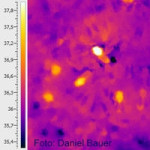Studies on the temperature of Varroa-parasitised and non-parasitised brood as a possible triggering factor for the hygienic behaviour of honey bees
| Funding code: | |
| Acronym: | |
| Involved employees: | S. Al Kathani, Prof. Dr. K. Bienefeld |
| Co-operation partners: | |
| Duration: | 2004 -2010 |
| Financing: | F. Schaumann Stiftung |
In many breeding programmes, bee colonies are selected for Varroa tolerance. These approaches are usually based on trait estimates of the whole colony. Due to the many sources of error inherent to measurement on a colony-level, there are attempts at LIB to evaluate traits of individual worker bees. There are strong indications that the recognition of parasitised brood is controlled by an altered fragrance pattern of diseased brood. Thermal imaging and infrared video recordings will serve to test whether a different incubation temperature affects the hygienic behaviour and whether or not it is suitable as a selection trait in standardised tests.
Publications:
- Al-Kahtani, S.; Bienefeld, K. (2006) Variability of egg weight of honeybee queens. Apidologie 37(5), 622 - 623
- Al-Kahtani, S.; Bienefeld, K. (2012) The Nasonov Gland Pheromone is involved in recruiting honeybee workers for individual larvae to be reared as queens Journal of Insect Behavior 25(4), 392-400
- Al-Kahtani, S.; Wegener, J.; Bienefeld, K. (2013) Variability of prenatal maternal investment in the honey bee (Apis mellifera) Journal of Entomology 10(1), 35-42


